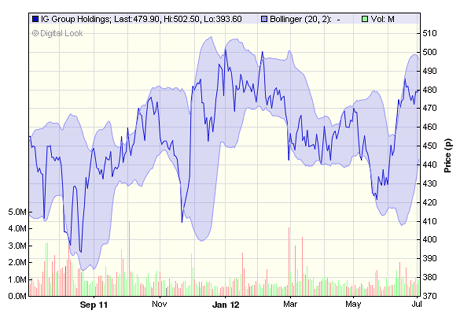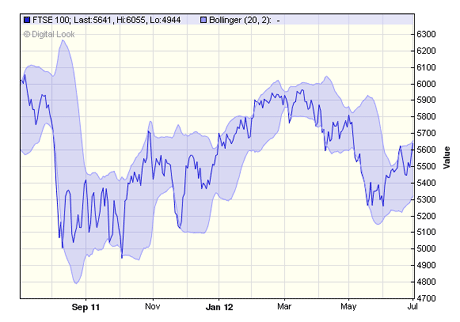When you're eyeing up a trade, it usually pays to take your time and wait for a discount. That was the point I was making last week.
That advice stirred a couple of readers to question "so, what is a decent discount, and from what price should I be discounting?"
Great questions. How hard should you drive a bargain? That's what I want to talk about today.
MoneyWeek
Subscribe to MoneyWeek today and get your first six magazine issues absolutely FREE

Sign up to Money Morning
Don't miss the latest investment and personal finances news, market analysis, plus money-saving tips with our free twice-daily newsletter
Don't miss the latest investment and personal finances news, market analysis, plus money-saving tips with our free twice-daily newsletter
I'll show you the three most important factors in what you might call your haggle ratio. And we'll look at a fantastic tool that'll help you determine your in-price.
Tip 1: The tool I can't live without
High-street retailers use the sales to flog off stuff they can't shift. Usually they've misjudged demand, or the stuff has simply gone out of fashion. But when it comes to the classic staples, the discounts are far less generous.
In the world of investments, your classic staples might be defensive bonds, while more faddish and exciting shares are your fashion items you'll often find them in the sales.
And to help us see when an investment is in the sales, I use a very handy charting tool: Bollinger bands.
IG Index one-year chart with Bollinger bands

Bollinger bands are incredibly useful it's the blue shaded area on the chart. For most charting packages (here I've used digitallook.com) the shaded area shows two standard deviations from the stock's 20-day moving average.
Now don't worry if you don't understand what that means. After all, you don't need to know how a four-stroke engine works to drive your car! Just suffice it to say that a share-price should stay within the confines of its bands 95% of the time.
That's incredibly useful information. If (as is the case for this chart right now!) the share price is near the top of its band, then it's probably worth waiting a little while. If you can pick up the stock nearer the bottom of the band, then you're probably getting a better deal. Looking at this chart, I can see several occasions where you could have saved up to 10% on your in-price by biding your time.
Of course, Bollinger bands aren't foolproof. You can be drawn in while the stock looks cheap (near the bottom of the band) only to find that it falls further. But the benefit of this tool is it keeps you from buying a stock in the days (or weeks) when everyone else is buying and the price is pumped up. It helps you pick out most of the down-days.
But as I said at the outset, some stocks just don't get discounted that much. And the beauty of the Bollinger bands is that they take account of this very fact.
If you look closely at the chart, you'll notice that the bands get wider when the stock is more volatile. Do you see how in March and April, the bands narrowed? Basically there was much less volatility in IG's shares around that time... and that meant not much chance of a discount.
With a non-volatile stock (what I'd like to call the old classics) the bands are always tighter. They'll help guide you to what sort of discount you should be asking.
Tip 2: Sometimes you shouldn't care about price
The second factor that determines your discount level is what you might call conviction. You'll often hear stockbrokers refer to their conviction stocks' that is the ones they really like.
If I'm totally convinced about a stock, I may not risk waiting for my discount window. Frankly, I may even pay a premium. Take the Co-op bond I covered last week. Though the price had moved up a few pence after I published my article, some would have still felt it was a good buy and a great addition to their portfolio. And it works the other way too. If you're not 100% about a tip, then you're more likely to wait for a decent discount.
I know we'd all like to feel 100% about any purchase, but the truth is some investments will always feel more dicey. So you wait for a decent discount before you buy.
And that's fine, but be careful. In the same way that the sales' may tempt you into buying a pair of duff shoes, you could end up with a duff investment too. If you get a big enough discount, things may turn out all right.
I've bought loads of duff stocks in the past, but I've still made money on many of them. So long as you get a great in-price, you can wait for the stock's day in the sun. As they say, every dog has its day'. And remember to use the Bolly bands to guide you out... that is, sell at the top of the band.
Tip 3: Decide: pension, or trading account?
The shorter the time-frame over which you're operating, the keener the price must be.
With some strategies I may only be looking to make a couple of percentage points profit and it may be over just a couple of days. In this case, my in-price is key to determining whether I make a profit, or loss.
But other investments are for the long haul and the pennies may be meaningless. I'll use today's FTSE 100 chart to show you what I mean...

If I were trading the FTSE 100 for short-term gain (as I sometimes do), then there's no way I'd be a buyer today. The Bolly bands say that I should probably wait before taking a long position. Of course I could short it from here... but I'm not going to.
In fact, I continue to drip some cash into some of my favourite yield-stocks on behalf of my pension fund. It has a long-term outlook, I'm not too fussed if I pay a few pence more than perhaps I should.
As far as my pension fund is concerned, I'm taking a 20-year view. I don't think the 20-day moving average is going to bother me too much over that timescale.
I hope you've found the old Bolly-bands helpful. I'm not a massive charting fiend, but from my perspective this simple tool is one I wouldn't want to live without.
Most of the free online charting packages will allow you to include Bollinger bands. Before rushing in to a buy (or a sell), take a look at where the price is relative to its band.
This article is taken from the free investment email The Right side. Sign up to The Right Side here.
Important Information
Your capital is at risk when you invest in shares - you can lose some or all of your money, so never risk more than you can afford to lose. Always seek personal advice if you are unsure about the suitability of any investment. Past performance and forecasts are not reliable indicators of future results. Commissions, fees and other charges can reduce returns from investments. Profits from share dealing are a form of income and subject to taxation. Tax treatment depends on individual circumstances and may be subject to change in the future. Please note that there will be no follow up to recommendations in The Right Side.
Managing Editor: Frank Hemsley. The Right Side is an unregulated product published by Fleet Street Publications Ltd.
Fleet Street Publications Ltd is authorised and regulated by the Financial Services Authority. FSA No 115234. https://www.fsa.gov.uk/register/home.do
Get the latest financial news, insights and expert analysis from our award-winning MoneyWeek team, to help you understand what really matters when it comes to your finances.
MoneyWeek is written by a team of experienced and award-winning journalists, plus expert columnists. As well as daily digital news and features, MoneyWeek also publishes a weekly magazine, covering investing and personal finance. From share tips, pensions, gold to practical investment tips - we provide a round-up to help you make money and keep it.
-
 UK sets out crypto regulatory proposals
UK sets out crypto regulatory proposalsThe government has tabled legislation that sets out a regulatory framework for cryptocurrencies, while the regulator will consult on balancing innovation and consumer protections
-
 What does an interest rate cut mean for my pension?
What does an interest rate cut mean for my pension?Interest rates have been cut from 4% to 3.75%. For pension savers and retirees the effects of the drop will depend on the type of retirement pot they have, but could be significant.

